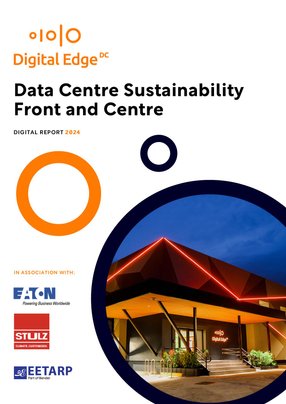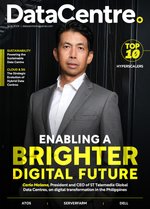Digital Edge is a company on a determined mission to bridge the digital divide across Asia, taking world-class infrastructure in the form of data centres to all four corners of the continent, including developing and developed markets.
Some, like Japan and South Korea, are well positioned in this space, but nations including Indonesia, the Philippines, and India lag significantly behind in many key areas.
Digital Edge is, therefore, working round the clock to close the gap, primarily by establishing state-of-the-art, energy-efficient data centres.
Since 2020, the organisation has acquired, built and now operates data centres in China, Indonesia, Japan, South Korea and the Philippines, while more are under construction in India.
It also offers interconnection and fibre services to enable customers to access a broader digital ecosystem.
Backed by Stonepeak, a leading international alternative investment firm that has made a US$1bn capital commitment, Digital Edge is well on the way to establishing a market-leading data centre platform.
Growth over the past four years has been exponential, to the extent that the business now has 17 data centres in six markets and more than 450 employees spread across the region. Its EDGE2 data centre recently opened in Jakarta, while it is anticipated that the new SEL2 facility in Seoul will come online in the autumn of this year.
Improving power usage effectiveness
It’s fair to say sustainable data centre design has become more important than ever before, given the power-hungry AI and hyperscale deployments which are increasingly dominating the industry.
According to Wavestone, data centres currently account for around 4% of global electricity consumption, while the carbon footprint of the wider IT sector is estimated at 1.4% of overall global emissions. AI server deployment will inevitably require more power and more water.
Jay Park, Founder and Chief Development Officer at Digital Edge, says the key to reducing electricity consumption and carbon footprint is to improve power usage effectiveness (PUE), while he also advocates a more considered approach towards water consumption.
Park points to research carried out by the Institute of Electrical and Electronics Engineers (IEEE), which found it takes approximately four gallons of water to produce one kWh of power.
“For the 20MW data centre, which is equivalent to our Jakarta EDGE2 data centre, if we reduce PUE by 0.2 we’ll be able to save 140 million gallons of water per year at the power-generation end,” he reveals.
“This equates to 200 Olympic-sized swimming pools. If we’re talking about the bigger companies, which are building 100MW data centres, it would be more than 1,000 pools each year – and that’s a lot of water.”
Leveraging tech to enhance efficiency
Park’s take is that, as a data centre constructor and operator, investing in energy efficiency can only be a win-win situation for Digital Edge.
Evidently, some servers will operate at a higher temperature, while others will require more air. What’s important is that even making “little savings” is helping to reduce the overall carbon footprint.
An innovative cooling system at Digital Edge’s data centre in Jakarta, for example, has resulted in electricity savings that could power around 1,500 residential homes, while it’s estimated the technology has achieved water savings to fill 200 of those Olympic pools.
Digital Edge is, in fact, the first co-location data centre company in Asia to install Nortek StatePoint® liquid cooling technology, having done so at both its newly-built sites in Manila and Jakarta.
“This means we’re able to reduce power and water consumption significantly compared to current technologies – a typical water-cooled chiller and DX system,” Park explains.
A useful demonstration of its effectiveness can be found by examining the Manila facility, NARRA1, which achieved a PUE of 1.15 at 75% load during phase on commissioning, surpassing an already-ambitious design PUE of 1.193.
This compares to a global PUE average of 1.55.
“You can see we're reducing our PUE by 0.4 in comparison to the average site, which is huge,” adds Park. “We believe this makes NARRA1 one of the most energy-efficient data centres in the Philippines.”
Taking a holistic approach
Power usage effectiveness is, of course, a standard metric for measuring power consumption in data centres, pitting the energy used by computing equipment against the energy delivered.
While using PUE is a popular and easily-applied method for calculating energy efficiency, it has its limitations in that it doesn’t necessarily take into account all internal and external factors.
Despite Digital Edge’s impressive PUE performance across its various sites, Park contends that operators should be looking beyond PUE and taking a more holistic approach.
“To achieve true sustainability, we need to look beyond the data centre,” he says. “What I mean is we must look from start to end – the power plan all the way to the servers. It can’t just be the data centre piece, but the whole thing.”
A number of other factors must also come into the equation, including the sourcing of renewable energy.
Digital Edge’s EDGE1 data centre in Jakarta, for example, is 100% renewable.
“For some data centres renewable energy isn’t available and we understand that,” Park continues, “but, where it's available, we need to procure that power.”
The firm’s development lead also advocates using recycled or sustainable build materials for new data centre projects where possible, in addition to educating customers about new technologies and innovations that will help reduce their carbon footprint.
Sustainability: At the heart of design and build
As implied by Park, there exists a belief at Digital Edge that sustainability must be positioned right at the heart of the data centre design and build process.
“Baking” environmentally beneficial elements into each data centre from day one is a lot more straightforward than retrofitting at a later date.
As a minimum, Digital Edge aims for LEED silver certification for green building across all its new sites, which has already been exceeded by its two most recent projects.
Ultimately, the company is focused on three key areas from day one: greenhouse gas (GHG) emissions, resource management and the circular economy.
“With GHG emissions, every little thing helps,” Park adds. “We have to look at every detail that will make our carbon footprint smaller and smaller.
“At some sites we’ve worked with vendors that provide data centre piping made from recyclable plastic, which has a lower carbon footprint than the metal alternative.”
Resource management, meanwhile, is centred on maximising energy efficiency, achieved via methods such as the aforementioned use of innovative cooling technology to significantly reduce annual power usage.
Finally, Digital Edge considers the full lifecycle of any data centre development and prioritises circular economy principles.
The NARRA1 facility in Manila, for example, is located on a brownfield site that reused 100% of the building envelope, while recycled materials were used for construction wherever possible.
Partnerships propel Digital Edge forward
Digital Edge is fortunate in that it can count on a host of key partners to help turn vision into reality.
Eaton, Eetarp, Stulz, Kohler, Cummins, Caterpillar, Schneider Electric and Nortek are just a handful of those cited by Park as being crucial to facilitating innovation and ensuring operations run smoothly.
Park estimates that electrical equipment makes up around 30% of each data centre project for Digital Edge. As one of the world’s largest suppliers of such materials, Eaton provides Digital Edge with transformers, distribution boards, breakers and beyond, while consistently supporting the business when tight schedules come into view.
Meanwhile, air handling units make up around 10%, which is why Digital Edge looks to the reliability of Stulz for the provision of these units – allowing important projects such as those in Manila to be delivered on time.
Eetarp is another firm with which Digital Edge has worked closely to monitor power usage, the air control system and cooling system. The business was “tremendous”, says Park, during the commissioning phase for the new Manila site and in helping get the data centre online.
“It’s so important to establish close partnerships because we can’t win unless we get the right supplies from our vendors,” he adds.
In future, Digital Edge intends to share its plans and build schedules with vendors early on in a bid to avoid supply and procurement issues arising further down the line.
“We recognise our partners have their own suppliers of parts and materials,” Park concludes.
“The plans we share don’t have to be 100% accurate but, just by sharing our schedule as closely as possible, we can better understand our partners and the challenges and hardship they’re going through. It’s going to be essential to our business.”
**************
Make sure you check out the latest edition of DataCentre Magazine and also sign up to our global conference series - Tech & AI LIVE 2024
**************
DataCentre Magazine is a BizClik brand






